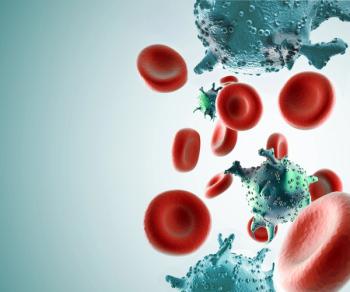
- Oncology Vol 28 No 4_Suppl_1
- Volume 28
- Issue 4_Suppl_1
(S035) Peripheral and Lymphatic Radiation (RT) Doses With Treatment on RTOG 9413: Immunosuppression or Scattered Doses and Death From Second Cancers?
This study estimates RT doses received by organs of interest during protocol treatment to determine whether the findings might explain these observations.
Josephine Chen, PhD, Alexei Polishchuk, MD, PhD, Bruce A. Faddegon, PhD, Angelica Perez-Andujar, PhD, Mack Roach, MD; University of San Francisco, California
Purpose: Long-term results from Radiation Therapy Oncology Group (RTOG) 9413 show an improvement in biochemical (PSA) failure for patients treated with neoadjuvant androgen suppression (NHT) and whole-pelvis radiotherapy (WPRT) compared with NHT and prostate-only radiation (PORT) but no improvement in survival. There appears to be an increased risk of death from second cancers (SCs), most notably among patients treated with WPRT and adjuvant hormone therapy (AHT), despite the fact that the incidence of SCs is not statistically higher for WPRT. The biologic processes underlying these unexpected results are presently not understood and merit further exploration. This study estimates RT doses received by organs of interest during protocol treatment to determine whether the findings might explain these observations.
Materials and Methods: We generated 6 and 18 MV WPRT (50-Gy pelvic irradiation plus boost) and PORT plans for an adult male phantom in accordance to protocol guidelines, with a total prostate dose of 70 Gy for all four plans. The plans were delivered, photon doses were measured using thermoluminescent dosimeters within the phantom, and Monte Carlo dose calculations were performed. Neutron dose equivalents for 18 MV plans were estimated using literature-reported values. To explore possible RT effects on the immune system, dose-volume histograms for the major lymphatic regions were calculated for WPRT and PORT and compared with an 8-Gy total lymphoid irradiation (TLI) technique, used for immune suppression in patients experiencing heart transplantation rejection.
Results: Ranges of total dose equivalent were estimated for organs associated with death from SCs. Lung and esophageal doses were on the order of 70 mSv for six MV PORT and 70–150 mSv for six MV WPRT. The dose equivalent ranges for 18 MV PORT and WPRT had large contributions from neutrons, and both were on the order of 100–250 mSv. The pancreas dose ranged from 150–250 mSv for PORT and approximately doubled for WPRT. Large ranges were calculated for bladder and rectum, which lay within the treatment field. The colon dose extended to 50 Sv for WPRT but was below 3 Sv for PORT. Approximately one-fourth of the major lymphatics received 8 Gy with WPRT, while one-tenth did so with PORT. The mean lymphatic dose with WPRT was higher than with TLI.
Conclusion: The estimated scattered doses to organs associated with SC were generally low, and there was large overlap between the dose ranges for WPRT and PORT treatment. This may be reflected in the statistically insignificant difference in SC incidence that was observed. The mean dose to the lymphatics was comparable to mean doses delivered under TLI. This suggests a new hypothesis-that the increased risk of death from SCs may be in part due to pre-existing second cancers that grew more quickly when immune surveillance was compromised. More work in this area is needed.
Proceedings of the 96th Annual Meeting of the American Radium Society -
Articles in this issue
Newsletter
Stay up to date on recent advances in the multidisciplinary approach to cancer.

















































































